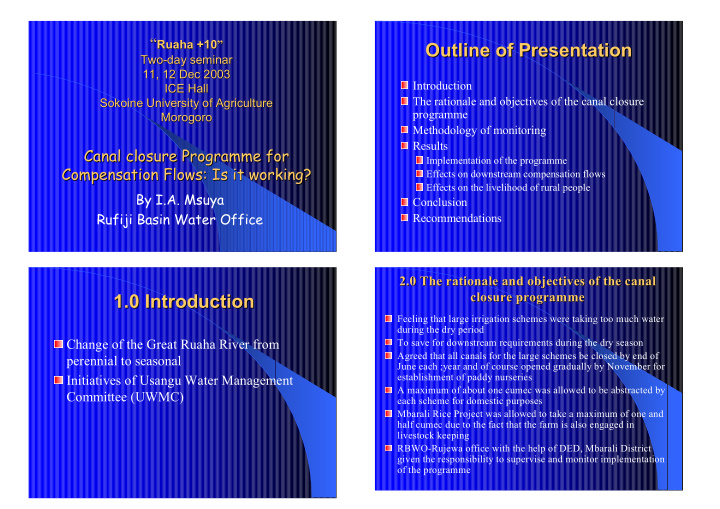



“ Ruaha “ Ruaha +10 +10 ” ” Outline of Presentation Outline of Presentation Two- -day seminar day seminar Two 11, 12 Dec 2003 11, 12 Dec 2003 Introduction ICE Hall ICE Hall The rationale and objectives of the canal closure Sokoine University of Agriculture Sokoine University of Agriculture programme Morogoro Morogoro Methodology of monitoring Results Canal closure Programme Programme for for Canal closure Implementation of the programme Compensation Flows: Is it working? Compensation Flows: Is it working? Effects on downstream compensation flows Effects on the livelihood of rural people By I.A. Msuya Conclusion Rufiji Basin Water Office Recommendations 2.0 The rationale and objectives of the canal 2.0 The rationale and objectives of the canal closure programme programme 1.0 Introduction closure 1.0 Introduction Feeling that large irrigation schemes were taking too much water during the dry period Change of the Great Ruaha River from To save for downstream requirements during the dry season Agreed that all canals for the large schemes be closed by end of perennial to seasonal June each ;year and of course opened gradually by November for establishment of paddy nurseries Initiatives of Usangu Water Management A maximum of about one cumec was allowed to be abstracted by Committee (UWMC) each scheme for domestic purposes Mbarali Rice Project was allowed to take a maximum of one and half cumec due to the fact that the farm is also engaged in livestock keeping RBWO-Rujewa office with the help of DED, Mbarali District given the responsibility to supervise and monitor implementation of the programme
3.0 Methodology 4.0 Results 3.0 Methodology 4.0 Results Kapunga and Mbarali irrigation schemes are Spot discharge measurements in canals actually abstracting less than what they have been and drains allocated Monitoring of zero flow days at Exception is late October to November due to Nyaluhanga gauging station paddy nurseries establishment Decreasing number of zero flow days at Nyaluhanga gauging station since 2001 E.g. 1999: River dried from 24/10 to end of December 2003: River dried from 22/11 to 30/11 6.0 Conclusion 6.0 Conclusion 5.0 Effects of the closure programme programme on on 5.0 Effects of the closure the livelihood of rural people the livelihood of rural people Canal closure programme seems to have Too much water going into the Ifushiro reduced the number of zero flow days as swamp reduces valley bottom farming, flood monitored at Nyaluhanga recession agriculture, fishing and grazing Has some negative impacts on the livestock, resulting into reduced incomes livelihood of some of the rural people Increased weeding load (no enough water to suppress weeds prior to transplanting) Shorter period for growing paddy, hence stiff competition for hired labour resulting into increased paddy production costs
Recommendations Recommendations More time and an in-depth study be undertaken to ascertain the long-term effects of the canal closure programme Efforts should be increased to bring on board the smallholder farmers who cultivate the remaining 75% of the paddy producing area. First priority should be given to farmers from remaining perennial rivers
Recommend
More recommend